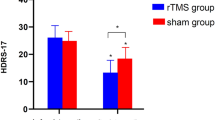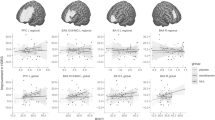Abstract
Purpose
Repetitive transcranial magnetic stimulation (rTMS) is a non-invasive and safe alternative to electroconvulsive therapy for treatment-resistant depression (TRD). After rTMS, changes in brain SPECT perfusion have been remotely identified within medial temporal limbic areas, while no local effects have been found within the left dorsolateral prefrontal cortex (DLPFC)—i.e. under the coil. Functional changes in connectivity may underlie these remote effects. Interestingly, functional connectivity has been recently investigated using perfusion SPECT, and abnormalities identified in TRD patients. The aim of the present study is to evaluate perfusion and connectivity SPECT changes in TRD patients after rTMS of the left DLPFC. We hypothesize that changes in DLPFC networks may explain remote hypoperfusions found after rTMS.
Methods
Fifty-eight TRD patients underwent a brain SPECT before and after high-frequency rTMS of the left DLPFC. Whole-brain voxel-based changes in perfusion were evaluated with SPM8, and inter-regional correlation analysis performed to study left DLPFC functional connectivity (p < 0.005, corrected for cluster volume).
Results
After rTMS, patients were significantly improved on Beck Depression Inventory score (p < 0.0001). Considering a 50% reduction threshold, 27 patients were identified as responders (47%). After rTMS, perfusion changes were not found locally within the left DLPFC, but remotely within the bilateral temporal lobes, including limbic areas. Inter-regional correlation SPECT analysis brings out a decrease of connectivity between the left DLPFC and both the cingulate/medial frontal cortex and bilateral medial temporal limbic areas, in relation with the clinical response.
Conclusions
rTMS of DLPFC in TRD patients leads to remote temporal hypoperfusions in relation with changes in functional connectivity between the DLPFC and the default mode network, especially including medial temporal limbic areas.


Similar content being viewed by others
References
Baldwin RC, Simpson S. Treatment resistant depression in the elderly: a review of its conceptualisation, management and relationship to organic brain disease. J Affect Disord. 1997;46:163–73.
Richieri R, Boyer L, Faget-Agius C, Farisse J, Mundler O, Lançon C, et al. Determinants of brain SPECT perfusion and connectivity in treatment-resistant depression. Psychiatry Res. 2015;231:134–40.
Paillère Martinot M-L, Galinowski A, Ringuenet D, Gallarda T, Lefaucheur J-P, Bellivier F, et al. Influence of prefrontal target region on the efficacy of repetitive transcranial magnetic stimulation in patients with medication-resistant depression: a [(18)F]-fluorodeoxyglucose PET and MRI study. Int J Neuropsychopharmacol. 2010;13:45–59.
Richieri R, Boyer L, Padovani R, Adida M, Colavolpe C, Mundler O, et al. Equivalent brain SPECT perfusion changes underlying therapeutic efficiency in pharmacoresistant depression using either high-frequency left or low-frequency right prefrontal rTMS. Prog Neuropsychopharmacol Biol Psychiatry. 2012;39:364–70.
Richieri R, Boyer L, Farisse J, Colavolpe C, Mundler O, Lancon C, et al. Predictive value of brain perfusion SPECT for rTMS response in pharmacoresistant depression. Eur J Nucl Med Mol Imaging. 2011;38:1715–22.
Cilia R, Cho SS, van Eimeren T, Marotta G, Siri C, Ko JH, et al. Pathological gambling in patients with Parkinson’s disease is associated with fronto-striatal disconnection: a path modeling analysis. Mov Disord. 2011;26:225–33.
Kapucu OL, Nobili F, Varrone A, Booij J, Vander Borght T, Någren K, et al. EANM procedure guideline for brain perfusion SPECT using 99mTc-labelled radiopharmaceuticals, version 2. Eur J Nucl Med Mol Imaging. 2009;36:2093–102.
Greicius MD, Flores BH, Menon V, Glover GH, Solvason HB, Kenna H, et al. Resting-state functional connectivity in major depression: abnormally increased contributions from subgenual cingulate cortex and thalamus. Biol Psychiatry. 2007;62:429–37.
Liston C, Chen AC, Zebley BD, Drysdale AT, Gordon R, Leuchter B, et al. Default mode network mechanisms of transcranial magnetic stimulation in depression. Biol Psychiatry. 2014;76:517–26.
Kang JI, Lee H, Jhung K, Kim KR, An SK, Yoon K-J, et al. Frontostriatal connectivity changes in major depressive disorder after repetitive transcranial magnetic stimulation: a randomized sham-controlled study. J Clin Psychiatry. 2016.
Wu M, Andreescu C, Butters MA, Tamburo R, Reynolds CF, Aizenstein H. Default-mode network connectivity and white matter burden in late-life depression. Psychiatry Res. 2011;194:39–46.
Li B, Liu L, Friston KJ, Shen H, Wang L, Zeng L-L, et al. A treatment-resistant default mode subnetwork in major depression. Biol Psychiatry. 2013;74:48–54.
Author information
Authors and Affiliations
Corresponding author
Ethics declarations
Funding
This work has been carried out thanks to the support of the A*MIDEX project (n° ANR-11-IDEX-0001-02) funded by the « Investissements d’Avenir » French Government program, managed by the French National Research Agency (ANR).
Conflict of interest
The authors declare that they have no conflicts of interest.
Ethical approval
All procedures performed in studies involving human participants were in accordance with the ethical standards of the institutional and/or national research committee and with the 1964 Helsinki Declaration and its later amendments or comparable ethical standards.
Informed consent
Informed consent was obtained from all individual participants included in the study.
Rights and permissions
About this article
Cite this article
Richieri, R., Jouvenoz, D., Verger, A. et al. Changes in dorsolateral prefrontal connectivity after rTMS in treatment-resistant depression: a brain perfusion SPECT study. Eur J Nucl Med Mol Imaging 44, 1051–1055 (2017). https://doi.org/10.1007/s00259-017-3640-5
Received:
Accepted:
Published:
Issue Date:
DOI: https://doi.org/10.1007/s00259-017-3640-5




